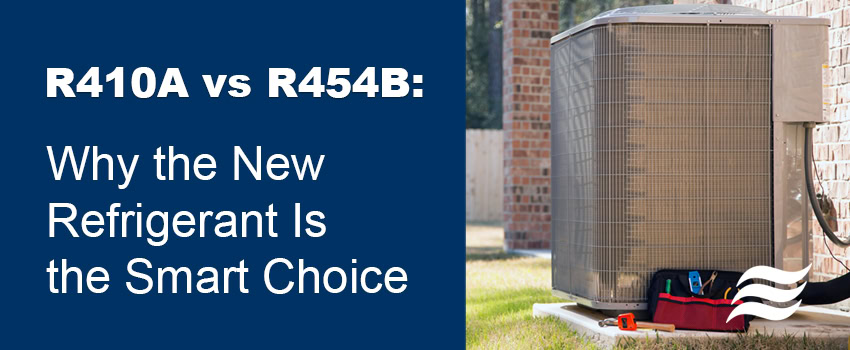
Why R454B Refrigerant Is the Smart Choice for Your New AC System
When investing in a new HVAC system, most Northern Virginia homeowners focus on upfront costs and energy efficiency ratings. But there's another factor that will significantly impact your costs over the next 15-20 years: refrigerant technology.
At Nichols & Phipps, we've guided hundreds of families through previous refrigerant transitions, including the shift from R22 to R410A. We've seen firsthand how choosing the right technology protects your investment, while choosing outdated technology leads to higher costs and frustration down the road.
Today, R454B refrigerant represents the smart choice that will protect your investment for years to come. Let's explore why R454B refrigerant is the superior option and how making the right choice now can benefit you long-term.
Understanding the Refrigerant Timeline: From R22 to R454B
To understand why refrigerant choice matters so much, it helps to know the history of these cooling chemicals and why they evolve.
R22 (Freon): The Original Standard (1960s-2010)
R22, commonly known as Freon, was the industry standard for decades. It worked reliably, but scientists discovered it was damaging the ozone layer. The EPA phased out R22 production completely by January 1, 2020.
Current status: Only existing supplies remain, making R22 expensive, sometimes costing several hundred dollars or more to recharge a system.
R410A (Puron): The Bridge Technology (2010-2024)
R410A, marketed as Puron, replaced R22 as the standard. It doesn't damage the ozone layer, but it has a high Global Warming Potential (GWP), meaning it contributes significantly to climate change when released into the atmosphere.
Current status: Production ended January 1, 2025. Existing inventory is still being sold and can be installed through 2025, but supplies are limited and may become more expensive over time.
R454B (Puron Advance): The Future Standard (2025 & Beyond)
R454B refrigerant represents the next generation of refrigerant technology. It has a 78% lower Global Warming Potential than R410A while maintaining excellent performance characteristics.
Current status: All new HVAC systems manufactured after January 1, 2025, are required to use R454B refrigerant or other low-GWP alternatives.
Why Buying Technology That's Being Phased Out Creates Problems
When you invest in technology that's being discontinued, you face predictable challenges that affect both your wallet and your comfort.
Immediate Consequences
Limited Future Supply: With R410A production ended, what's available today won't be available indefinitely.
Instant Obsolescence: Your “new” system is built with yesterday's technology, which affects its long-term value and serviceability.
No Return Policy: Unlike other major purchases, you can't return an HVAC system if you later prefer different technology.
Long-Term Financial Impact
Increasing Repair Costs: As R410A becomes less available, the cost of refrigerant for repairs may increase. We saw this pattern with R22 – what used to cost around $100 to recharge now costs significantly more.
Parts Availability: When manufacturers focus on new technology, replacement parts for older systems become harder to find and more expensive.
Premature Replacement: Many homeowners with R22 systems replaced units that were only 10-12 years old because repair costs exceeded replacement costs.
Why R454B Refrigerant Makes Financial Sense
Refrigerant Isn't Consumable
One important fact many homeowners don't understand: refrigerant isn't like motor oil that gets used up over time. In a properly functioning system, refrigerant circulates indefinitely. If your system is low on refrigerant, you have a leak that needs repair.
When a leak occurs, the entire system must be evacuated, the leak repaired, and the system refilled with fresh refrigerant. This service can be expensive, especially with phase-out refrigerants.
R410A Price Trajectory
Since R410A production has ended, existing supplies may become more expensive over time. While current prices remain reasonable, this could change as dealers work through remaining inventory.
Long-Term Service Availability
R454B refrigerant systems ensure long-term parts and service availability. When you invest in current technology, you're protecting your ability to maintain and repair your system for its entire 15-20 year lifespan.
The R454B Refrigerant Advantage: Why It's Worth the Investment
R454B refrigerant systems offer several compelling advantages that make them the smart long-term choice for Northern Virginia homeowners.
Environmental Benefits That Protect Your Investment
78% Lower Global Warming Potential: R454B refrigerant has a GWP of just 466, compared to R410A's GWP of 2,088. This dramatic improvement means R454B refrigerant won't face the regulatory pressure that led to R410A's phase-out.
Energy Performance: R454B refrigerant systems can deliver improved energy efficiency compared to comparable R410A systems, which may help keep utility bills manageable over the life of your system.
Current Regulatory Compliance: R454B refrigerant meets current environmental regulations, making it the required choice for new systems.
Performance & Reliability
Similar Operating Characteristics: R454B refrigerant behaves very similarly to R410A in terms of cooling capacity and system performance, making the transition seamless for homeowners.
Proven Technology: While R454B refrigerant is new to widespread U.S. adoption, it has been tested extensively, including validation through the U.S. Department of Energy's Cold Climate Heat Pump Challenge.
Wide Temperature Range: R454B refrigerant maintains consistent performance across the temperature extremes we experience in Northern Virginia, from summer highs in the 90s to winter lows below freezing for heat pump applications.
Addressing Common R454B Refrigerant Concerns
“The Technology Is Too New”
R454B refrigerant has undergone extensive testing and field trials. Major manufacturers like Carrier, Trane, Lennox, and Johnson Controls have invested heavily in R454B refrigerant technology because they're confident in its performance and longevity.
“It Costs More Upfront”
Yes, R454B refrigerant systems currently cost about 10-15% more than remaining R410A inventory. However, this price difference is temporary and will reverse as R410A supplies become scarce. More importantly, the slightly higher upfront cost is quickly offset by:
- Lower energy bills due to improved efficiency
- Avoided future repair cost increases
- Not having to replace your system prematurely
- Long-term parts and service availability
“I've Heard About Flammability”
R454B refrigerant is classified as A2L (low toxicity, low flammability), which means it requires specific conditions to ignite – conditions that are extremely unlikely in normal operation. Modern R454B refrigerant systems include leak detection and safety features, and our technicians receive specialized training for safe handling.
What This Means for Different Homeowner Situations
If Your Current System Uses R22
If you have an R22 system that needs repair, replacement with R454B refrigerant technology may be the better financial choice in many cases. Rather than investing significant money in refrigerant for an aging system, consider R454B refrigerant technology that will serve you for 15-20 years.
If Your Current System Uses R410A & Is Working Fine
If your R410A system is less than 10-12 years old and working well, continue maintaining it. Start planning for replacement when it reaches 12-15 years old, and choose R454B refrigerant technology when that time comes.
If You're Buying a New System
Choose R454B refrigerant technology. While R410A systems may still be available at lower prices, you're buying into a phase-out scenario that will cost more long-term.
If You Need Emergency Replacement
If your system fails unexpectedly, this is actually an opportunity to invest in current R454B refrigerant technology rather than extending the life of outdated equipment.
Making Smart HVAC Investments
Consider Total Cost of Ownership
When evaluating HVAC systems, look beyond the initial purchase price. Factor in:
- Energy efficiency and operating costs
- Expected service and repair expenses
- Refrigerant availability and pricing
- System longevity and replacement timing
Choose Experienced Contractors
Work with contractors who are trained and experienced with R454B refrigerant systems. At Nichols & Phipps, our technicians receive ongoing training on the latest refrigerant technologies to ensure proper installation and service.
Plan for the Future
Your HVAC system is a long-term investment. Choose technology that will remain supported and cost-effective to maintain throughout its service life.
The Nichols & Phipps Approach
At Nichols & Phipps, we don't work on commissions, so we have no financial incentive to push expensive equipment or outdated technology. Our goal is straightforward: recommend the right solution that fits your home and budget.
When we recommend R454B refrigerant systems, it's because we understand the long-term value proposition. We've seen what happens to homeowners who get stuck with phased-out refrigerants, and we want to help you make informed decisions.
Our Commitment to Honest Service
When it's broken, we fix it. When it's unfixable, we replace it. When it's working, we keep it that way. This philosophy extends to our refrigerant recommendations – we'll always tell you the truth about what's best for your specific situation.
Proper Installation & Service
R454B refrigerant systems require proper installation and ongoing maintenance to deliver their full benefits. Our certified technicians understand the nuances of this technology and ensure your system operates efficiently and reliably.
Frequently Asked Questions About R454B Refrigerant
Can R410A Systems Be Converted to R454B?
No, refrigerant conversion isn't feasible. The systems are designed specifically for their respective refrigerants, and conversion would require replacing most major components – essentially a complete system replacement.
How Long Will R410A Service Be Available?
While R410A service will continue for existing systems, expect increasing costs and decreasing availability over time. Most manufacturers are transitioning their focus and resources to R454B refrigerant technology.
Is R454B Available from All Manufacturers?
Yes, all major HVAC manufacturers now offer R454B refrigerant systems, as it's required for all new production starting in 2025.
Is R-454B toxic?
No, R-454B is not toxic. R-454B has low toxicity and is classified as non-toxic with an ASHRAE safety classification of A2L. The “A” in the A2L classification specifically indicates low toxicity, while the “2L” indicates mild flammability with low burning velocity.
Can R-454B be used safely in residential applications?
Yes. When installed by licensed professionals, R-454B refrigerant poses no fire hazard to homeowners. The A2L classification and built-in safety features make it suitable for residential use while providing better environmental performance than previous refrigerants.
Making Your Decision
Your HVAC system is a significant investment that will serve your family for 15-20 years. The refrigerant technology you choose today determines not just your initial costs, but your long-term maintenance expenses and system reliability.
R454B refrigerant systems represent current technology that meets today's environmental standards and regulatory requirements. While the upfront investment may be slightly higher, you're choosing proven technology that will remain supported throughout your system's lifespan.
Ready to explore your options? Contact Nichols & Phipps at (703) 670-8519 or visit us online to discuss your specific situation. We'll provide straightforward information about R454B refrigerant systems and help you understand how this technology fits your home's needs and budget.
When it comes to major home investments, the smart choice is current technology that delivers reliable performance and predictable maintenance costs. In 2025, that's R454B refrigerant technology.
